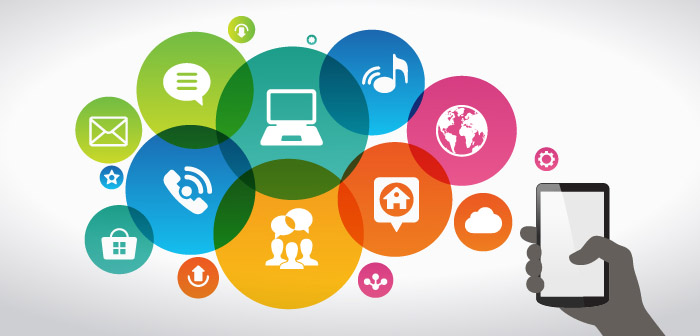
Whether your business involves Consumer or B2B products and services, changes in the digital marketing landscape continue to expand the potential role digital activities can play in your media outreach. Newer tactics such as retargeting campaigns, contextual advertising, programmatic buys, chat bots and other ways of engaging with customers certainly make digital activities as complex as anyone would want to manage.
To maximize effectiveness of an advertising media plan, one of the basic questions still remains: Should you place greater emphasis on digital initiatives today? Or should you continue to allocate a significant share of your budget for traditional activities such as print advertising that you have used in the past? What is an appropriate mix? The balance of this article provides general thoughts on that central issue.
Before embarking on a digital campaign and looking forward to its many advantages such as micro targeting and ease of measuring results, there are some things we would advocate. All of these suggestions may sound familiar as the tenets of content or "inbound" marketing:
• Understand your buyer’s journey
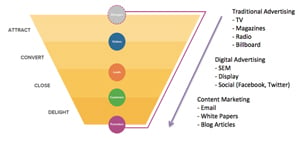
You’ll want to be sure your overall media strategy is doing its part in delivering messages that prospects will find valuable at each stage, from the time they first learn about products and services available to solve a problem or enhance their lives, to the time they move on to the consideration and purchase stages.
In developing content marketing campaigns, it’s helpful to envision a funnel to represent this buyer journey. At the top, or beginning of the journey, we might utilize traditional media such as magazines and broadcast for their advantages of broad reach to attract prospects. This first-level marketing “casts the net,” and then is followed by other initiatives that funnel prospects toward your website and other content.
• Have a content strategy
It’s great to look at website traffic reports and see the numbers rise and fall. But if you aren’t engaging prospects with multiple touches that nurture a relationship, the numbers will be little more than one-hit wonders.
The lesson? Bringing prospects to your site through traditional or digital means is key – but it is not enough. You have to give them a reason to stay – to engage your brand through meaningful dialogue and content. That is where content marketing – sometimes called inbound marketing – comes into play.
With a content marketing strategy, the idea is to share timely information that prospects will find compelling and relevant as they progress from passive to active and purchase phases.
In this spectrum of marketing activities, traditional and digital media work hand in hand to feed the funnel. For example, a B2B marketer targeting design engineers might utilize trade journal advertising to raise awareness or SEM to capture those expressing interest in a particular topic. Things like white papers, technical articles, case studies and other more detailed content are used to satisfy the appetite of prospects actively considering brand choices (i.e., those who have landed on your website due to the media strategy).
Source for life cycle marketing visuals: HubSpot
So, getting back to the initial media budgeting question… balance is key. In the early stages of a new media campaign, focus may be on building the infrastructure for the inbound marketing program – constructing landing pages (response mechanisms) and developing content such as blogs, white papers and e-books. But the marketer must not lose site of the traditional and digital media’s roles of stimulating interesting and driving traffic to your website, which is where you ultimately engage your prospects and convert them to customers and advocates.
A 2019 report by DemandGen explored the relative importance of different content in driving decisions related to B2B purchases. For the 200 senior-level B2B executives surveyed, time plays a large part in content consumed. 73% of respondents say they have less time than in the past for reading and research. They typically consume 3 to 7 pieces of content before speaking with a salesperson. Valued most highly was trustworthiness of the source, with 97% ranking that factor as most influential, up from 78% in 2018.
Among the types of influencer content preferred, a library of good Case Studies leads the way in information value.
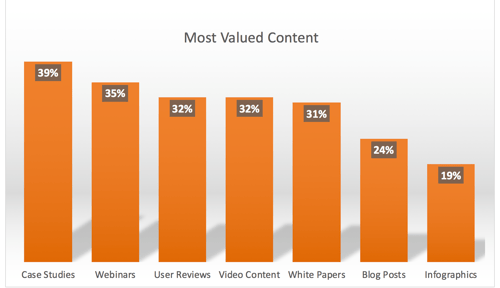
Source: DemandGen 2019
The direction is clear that there are many benefits in educating your prospects before the field sales team is called into action. Developing and deploying content requires a fair amount of research and writing, along with a platform for managing the contact database and activities. At Heinzeroth, we utilize HubSpot. There are other very good tools available as well including Marketo and Sharpspring.
• Stay close to customers
An inbound effort involves more than an update of your website’s “contact us” form. Typically, it includes many of the content categories noted above: social media initiatives, blogging, email campaigns, calls to action, landing pages, contests, eBooks, white papers and more, all tied to your external advertising and PR activities. If you do all of those things well and consistently, you will be in conversation with customers, not merely running ads.
In that spectrum of marketing activities, digital advertising provides the extra fuel to bring visitors to your website and move them along toward purchase. Once there, those visitors can be delighted with all of the great content and automated activities that will keep them moving toward purchase and becoming advocates of your brand.
Digital advertising offers numerous advantages in targeting and measurement, but shouldn’t be expected to do it all.
----
If you are considering a new direction for your marketing program, please give us a call. We may be able to give you a fresh perspective on how to move your communications plan toward an inbound strategy.
Addendum: About the growth of digital advertising.
At the beginning of each year, Ad Age publishes its Media Fact-Pack report on media spending for the previous year. And though your company may not be directly impacted by what the mega advertisers are doing, there are some takeaways that are noteworthy for anyone involved in marketing.
First, the expected results: Once again in 2018, digital media continued to overtake traditional media as advertisers adjust their focus on a U.S. adult population that is consuming media much differently than in past years. Predictably sliding in ad dollars are newspapers, magazines and radio.
Share of U.S. ad spending by medium
Source: Publicis Groupe's Zenith advertising forecasts, December 2018
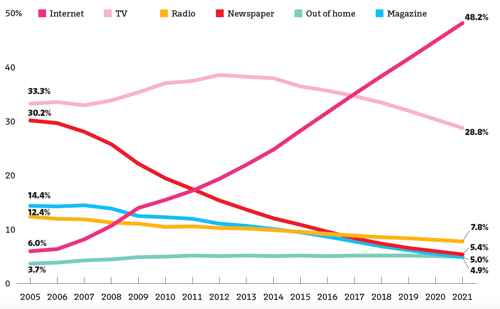
Still doing well are TV and out-of-home advertising
These sectors are the lone exceptions to this migration toward digital ad spending. TV and out-of-home media are indeed still standing strong, though falling slightly. They offer traditional values of entertainment, a variety of programming as well as extensive reach. TV is expected to account for 28.8% of revenue by 2021. Out-of-home: 5%.
Internet advertising has tripled in revenue share.
Forecast to be 48.2% of ad spending by 2021, digital media are the big story. The strong and continuing shift toward digital is a reflection of how U.S. adults are spending their media time. As noted in the figures below, time spent using digital media has risen to 225 minutes per day on average for adults. Younger consumers spend relatively more time on digital, up to 260 minutes according to Nielsen. TV still accounts for a significant share of media consumption.
Time Spent Using Media
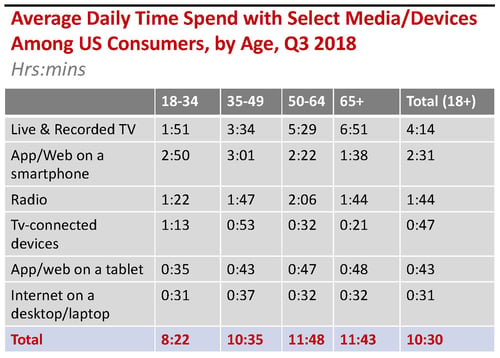
Source: Nielsen Total Audience Report, as cited by eMarketer and Radio Ink, March 18, 2019
Included in the digital time reported here is use of desktop and laptop computers, plus mobile phones and tablet devices for non-voice communications. There is substantial overlap, of course, as multi-tasking TV viewers watch their favorite programs while checking Facebook and email, visiting websites and texting on their mobile devices.


